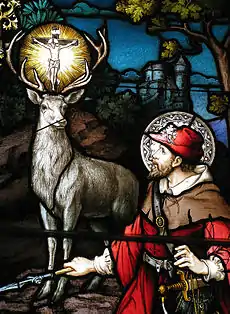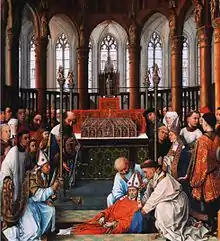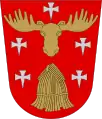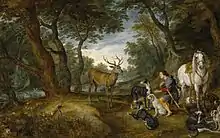Hubertus
Hubertus or Hubert (c. 656 – 30 May 727) was a Christian saint who became the first bishop of Liège in 708 AD.[1] He is the patron saint of hunters, mathematicians, opticians, and metalworkers. Known as the "Apostle of the Ardennes", he was called upon, until the early 20th century, to cure rabies through the use of the traditional St Hubert's Key.[2]
Saint Hubertus | |
|---|---|
 Saint Hubert (Franz Mayer & Co., St. Patrick's Basilica, Ottawa, Canada) | |
| "Apostle of the Ardennes" | |
| Born | c. 656–658 Toulouse |
| Died | 30 May 727 Voeren/Fourons near Liège |
| Venerated in | Roman Catholic Church Anglican Church Eastern Orthodox Church |
| Feast | 3 November |
| Attributes | gear nearby; knight with a banner showing the stag's head and crucifix; stag; stag with a crucifix over its head; young courtier with two hounds |
| Patronage | patron saint of hunters, mathematicians, opticians and metalworkers |
Hubertus was widely venerated during the Middle Ages. The iconography of his legend is entangled with the legend of martyr Saint Eustace. The Bollandists published seven early lives of Hubertus (Acta Sanctorum, November, i., 759–930 AD); the first of these was the work of a contemporary, though it is very sparing of details.
He died 30 May 727 AD in or near a place called (in Latin) Fura. In the later Middle Ages, this place was claimed to have been identified as Tervuren near Brussels, but recent scholarship considers Voeren (Fourons), a location much closer to Liège than Brussels, to be the likelier resting place.[3] His feast day is 3 November.
His other skills were mathematics and metalwork.
Early life
Hubertus was born probably in Toulouse about the year 656. He was the eldest son of Bertrand, Duke of Aquitaine.[4] As a youth, Hubert was sent to the Neustrian court of Theuderic III at Paris, where his charm and agreeable address led to his investment with the dignity of "count of the palace". Like many nobles of the time, Hubert was addicted to the chase. Meanwhile, the tyrannical conduct of Ebroin, mayor of the Neustrian palace, caused a general emigration of the nobles and others to the court of Austrasia at Metz.
Hubert soon followed them and was warmly welcomed by Pepin of Herstal, mayor of the palace, who created him almost immediately grand-master of the household. About this time (682) Hubert married Floribanne, daughter of Dagobert, Count of Leuven.[4] Their son Floribert of Liège would later become bishop of Liège, for bishoprics were all but accounted fiefs heritable in the great families of the Merovingian kingdoms. He nearly died at the age of 10 from "fever".
Spiritual conversion

His wife died giving birth to their son and Hubert retreated from the court, withdrew into the forested Ardennes, and gave himself up entirely to hunting. However, a great spiritual revolution was imminent. According to a late legend the following happened: On Good Friday morning, when the faithful were crowding the churches, Hubert sallied forth to the chase.
As he was pursuing a magnificent stag or hart, the animal turned and, as the pious legend narrates, he was astounded at perceiving a crucifix standing between its antlers, while he heard a voice saying: "Hubert, unless thou turnest to the Lord, and leadest an holy life, thou shalt quickly go down into hell". Hubert dismounted, prostrated himself and said, "Lord, what wouldst Thou have me do?" He received the answer, "Go and seek Lambert, and he will instruct you."
However, the story of the hart appears first in one of the later legendary hagiographies (Bibliotheca hagiographica Latina, nos. 3994–4002) and has been appropriated from the legend of Saint Eustace or Placidus. It was only attributed to St. Hubert in the 15th century.
Hubertus (German) is honored among sport-hunters as the originator of ethical hunting behavior.
During Hubert's religious vision, the Hirsch (German: deer) is said to have lectured Hubertus into holding animals in higher regard and having compassion for them as God's creatures with a value in their own right. For example, the hunter ought to only shoot when a humane, clean and quick kill is assured. He ought shoot only old stags past their prime breeding years and to relinquish a much anticipated shot on a trophy to instead euthanize a sick or injured animal that might appear on the scene.
Further, one ought never shoot a female with young in tow to assure the young deer have a mother to guide them to food during the winter. Such is the legacy of Hubert who still today is taught and held in high regard in the extensive and rigorous German and Austrian hunter education courses.
The legacy is also followed by the French chasse à courre masters, huntsmen and followers, who hunt deer, boar and roe on horseback and are the last direct heirs of Hubert in Europe. Chasse à courre (riding to hounds) is currently enjoying a revival in France. The Hunts apply a specific set of ethics, rituals, rules and tactics dating back to the early Middle-Ages. Hubert is venerated every year by the Hunts in formal ceremonies.
Religious career

Hubert set out immediately for Maastricht, for there Lambert was bishop who received him kindly, and became his spiritual director. Hubert now renounced all his very considerable honors, and gave up his birthright to the Aquitaine to his younger brother, Odo, whom he made guardian of his infant son, Floribert. Having distributed all his personal wealth among the poor, he studied for the priesthood, was soon ordained, and shortly afterwards became one of St. Lambert's chief associates in the administration of his diocese. By the advice of St. Lambert, Hubert made a pilgrimage to Rome in 708, but during his absence, Lambert was assassinated by the followers of Pepin. According to the hagiographies of Hubert, this act was simultaneously revealed to the pope in a vision, together with an injunction to appoint Hubert bishop of Maastricht.
He distributed his episcopal revenues among the poor, was diligent in fasting and prayer, and became famous for his eloquence in the pulpit. In 720, in obedience to a vision, Hubert translated St. Lambert's remains from Maastricht to Liège with great pomp and ceremonial, several neighboring bishops assisting. A basilica for the relics was built upon the site of Lambert's martyrdom, and was made a cathedral the following year, the see being removed from Maastricht to Liège, then only a small village. This laid the foundation of the future greatness of Liège, of which Lambert is honored as patron, and Hubert as founder and first bishop.
Hubert actively evangelised among the pagans in the extensive Ardennes forests and in Toxandria, a district stretching from near Tongeren to the confluence of the Waal and the Rhine.

Death
Hubertus died peacefully in a place called Fura, located 30 miles from Liège, 30 May 727 or 728. He was first buried in the collegiate St Peter's Church, Liège, but his bones were exhumed and transported to the Benedictine Abbey of Amdain ("Andagium", in French "Andage", the present-day Saint-Hubert, Belgium) in the Ardennes in 825. The abbey became a focus for pilgrimages, until the coffin disappeared during the Reformation. His feast day is 3 November, probably the date of the translation of his relics to Amdain.
Veneration
Hubert was widely venerated in the Middle Ages and partly because of his noble birth several military orders were named after him: the Bavarian,[5] the Bohemian International Order of St. Hubertus and that of the Archbishop-Elector of Cologne.
Hubertus, along with Quirinus of Neuss, Cornelius and Anthony, was venerated as one of the Four Holy Marshals (Vier Marschälle Gottes) in the Rhineland.[6][7] [8] The St. Hubertus Orden (Order of Saint Hubert), a chivalric order, was founded in 1444 by Gerhard V of Jülich and Berg.[9]
In the Anglican Communion, at least two churches were dedicated to Saint Hubertus within the Church of England.[10]
Patronage
Saint Hubert of Liège is patron of archers; dogs; forest workers; trappers; hunting; huntsmen;[4] mathematicians;[11] metal workers; smelters and the city of Liège.
St Hubert has been described as the patron saint of hunters when he became honoured by sportsmen as the originator of ethical hunting behaviour. However he renounced hunting after he had his vision. This was because his hunting life had been seen by God as an unholy life, which would lead him to hell, because it had become a false idol for him. He had also renounced his wealth and titles following his experience. According to the Jews in the Middle Ages, when St Hubert became a priest, clergy were forbidden to hunt and, if they did, they would have to take penance.[12]
God's voice to Hubertus was calling his attention to the fact that hunting is distracting him from fulfilling his religious duties on easter's Good Friday. Hunting in itself, common practice in the middle ages, is not being condemned.
Lambert sends Hubert to the Ardennes to live amongst the people and creatures of the forest. He studies to become a priest, and is soon ordained. Following Lamberts’s assassination, Hubert becomes Bishop of Maastricht, then of Liége. Throughout his life he remains known as the apostle of the Ardennes, venturing much into the forest, gaining the trust (and the faith) of its people through the outdoorsman skills acquired during his hunting life. Hubertus becomes a reference and a sought voice whenever matters of the forest are on the table. [13]
Gallery
 Saint Hubertus Deer, the coat of arms of the municipality of Hollola
Saint Hubertus Deer, the coat of arms of the municipality of Hollola
 A print in the style of an illuminated manuscript showing Hubert of Liège with the stag.
A print in the style of an illuminated manuscript showing Hubert of Liège with the stag. Russian Orthodox church and monastery, interior in Sint Hubert, Netherlands
Russian Orthodox church and monastery, interior in Sint Hubert, Netherlands Stained glass window in St Ethelbert's Church, Herringswell, Suffolk, dedicated to the memory of Llewellyn Sidney Davies.
Stained glass window in St Ethelbert's Church, Herringswell, Suffolk, dedicated to the memory of Llewellyn Sidney Davies. A zinc statue of Saint Hubert and a deer outside Bistra Castle in Slovenia
A zinc statue of Saint Hubert and a deer outside Bistra Castle in Slovenia Depiction of the miracle of the stag at Château d'Amboise, France.
Depiction of the miracle of the stag at Château d'Amboise, France. Glass window with St. Hubert from Vorarlberg, Austria.
Glass window with St. Hubert from Vorarlberg, Austria..JPG.webp) St. Hubert's stag as the logo of Jägermeister ("Master Hunter") liqueur.
St. Hubert's stag as the logo of Jägermeister ("Master Hunter") liqueur. Saint Hubertus Deer, the coat of arms of the city of Grodno
Saint Hubertus Deer, the coat of arms of the city of Grodno
See also
Notes
- Crystal, David (1994). The Cambridge Biographical Encyclopedia. Cambridge: Cambridge University Press. p. 471. ISBN 0521434211.
- St Hubert's Key in the Science Museum, London
- R. de la Haye, "Lambertus, laatste bisschop van Maastricht; Hubertus, eerste bisschop van Luik: Hun eigentijdse levensbeschrijvingen", Publications de la Société Historique et Archéologique dans le Limbourg (PSHAL) 143 (2007), 9–66.
- Brown, C.F. Wemyss. "St. Hubert." The Catholic Encyclopedia. Vol. 7. New York: Robert Appleton Company, 1910. 12 Aug. 2014
- Rudge, F.M. "Military Orders of St. Hubert." The Catholic Encyclopedia. Vol. 7. New York: Robert Appleton Company, 1910. 13 Aug. 2014
- Quirinus von Rom (von Neuss) – Ökumenisches Heiligenlexikon
- marschaelle
- "Die Kapelle". Archived from the original on 11 February 2012. Retrieved 28 March 2008.
- History of Orders of Chivalry
- Farmer, David Hugh (2004). The Oxford Dictionary of Saints. Oxford University Press. p. 414. ISBN 9780198609490.
Two churches were dedicated to him in England and the Sarum calendar eventually included his feast.
- "Saint Hubert of Liege". CatholicSaints.Info. 3 January 2009. Retrieved 18 January 2018.
- The School of Compassion by Dr Deborah Jones, Gracewing 2001
- History of St Hubertus, international order of Saint Hubertus (https://www.iosh-usa.com/about-us/history-of-st-hubertus)
External links
| Wikimedia Commons has media related to Saint Hubertus. |
- Painting from the National Gallery, London The Conversion of Saint Hubert